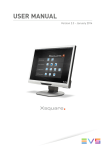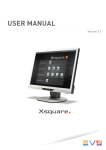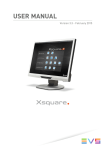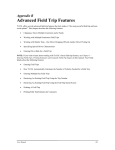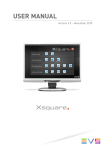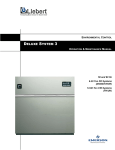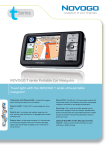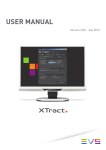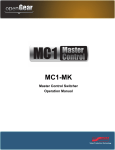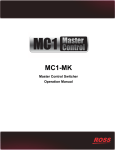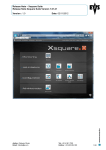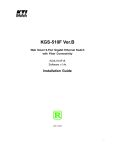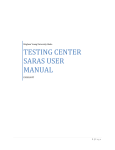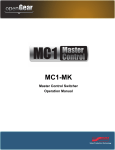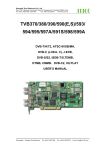Download Xsquare 03.02 User`s Manual
Transcript
USER MANUAL Version 3.2 - October 2014 USER MANUAL Xsquare 3.2 Copyright EVS Broadcast Equipment SA– Copyright © 2012-2014. All rights reserved. Disclaimer The information in this manual is furnished for informational use only and subject to change without notice. While every effort has been made to ensure that the information contained in this user manual is accurate, up-to-date and reliable, EVS Broadcast Equipment cannot be held responsible for inaccuracies or errors that may appear in this publication. Improvement Requests Your comments will help us improve the quality of the user documentation. Do not hesitate to send improvement requests, or report any error or inaccuracy on this user manual by e-mail to [email protected]. Regional Contacts The address and phone number of the EVS headquarters are usually mentioned in the Help > About menu in the user interface. You will find the full list of addresses and phone numbers of local offices either at the end of this user manual (for manuals on hardware products) or at the following page on the EVS website: http://www.evs.com/contacts. User Manuals on EVS Website The latest version of the user manual, if any, and other user manuals on EVS products can be found on the EVS download center, on the following webpage: http://www.evs.com/downloadcenter. I EVS Broadcast Equipment SA Issue 3.2.A - October 2014 Table of Contents TABLE OF CONTENTS II WHAT'S NEW? V 1. 1 INTRODUCTION 1.1. Product Overview 1 1.2. Accessing Xsquare 2 1.3. Xsquare User Interface 4 1.4. Configuration for Active Directory Integration 6 2. JOB INITIATORS 7 2.1. Concepts around Jobs 7 2.2. Configuring Targets 9 2.2.1. Target Window 2.2.2. Defining a Target 10 2.2.3. Publishing a Target 11 2.3. Configuring ScanXML 13 2.3.2. Merge Rules for ScanXML Jobs 15 2.3.3. Defining a ScanXML 17 2.3.4. Configuring ScanFolders 18 22 2.4.1. Job Destination Parameters 22 2.4.2. Clip Location on an EVS Server 23 CONFIGURATION 3.1. Orchestration 27 27 3.1.1. Introduction 27 3.1.2. Orchestration Rules 27 3.1.3. Orchestration Window 28 3.1.4. Cluster Area 30 3.1.5. Cluster Types 31 3.1.6. Engine Area 33 3.1.7. Selected Cluster Information Area 35 3.1.8. Managing Engine Clusters 38 3.1.9. Configuring Engines 40 3.2. Job Templates and Encoder Profiles II 13 2.3.1. ScanXML Window 2.4. Job Destinations 3. 9 41 3.2.1. Managing Templates and Profiles 41 3.2.2. Customizing Job Templates and Encoder Profiles 47 Table of Contents USER MANUAL Xsquare 3.2 4. MANAGING ICONS AND LABELS 4.1. Icons Manager 54 4.2. Labels Window 54 5. ADMINISTRATION 56 5.1. Introduction 56 5.2. Users 57 5.2.1. Users and Access Window 57 5.2.2. Managing Users 60 5.3. Roles 6. 62 5.3.1. Roles Window 62 5.3.2. Managing Roles 63 5.3.3. About Role Definition 65 5.3.4. Defining Roles 66 5.4. Groups 68 5.4.1. Groups Window 68 5.4.2. Managing Groups 71 MONITORING 74 6.1. Job Monitoring Window 74 6.2. Job Grid 76 6.3. Cluster Area 78 6.4. Manipulating and Analyzing Monitoring Data 80 6.5. Managing Monitored Jobs 81 6.6. EVS Server Monitoring Window 82 GLOSSARY Table of Contents 54 85 III USER MANUAL Xsquare 3.2 What's New? In the Xsquare manual, the icon has been added on the left margin to highlight information on new and updated features. The full list of modified and new features in version 3.2 is available in the release notes. Only changes linked to new features in version 3.2 and documented in the user manual are listed below: New Adobe Cluster • What's New? See section "Cluster Types" on page 31 V USER MANUAL Xsquare 3.2 1. Introduction 1.1. Product Overview Description Xsquare acts as an orchestrator that centralizes all job requests from client applications, and dispatches them to the most appropriate processing device, taking into account load balancing, job type, etc. The Xsquare solution offers the following advantages: 1. Introduction • Central orchestrator for all jobs • Global configuration tool for all processing devices • Global monitoring tool • Integration with old job processing 1 EVS Broadcast Equipment SA Issue 3.2.A - October 2014 Client Applications The Xsquare client is the device that initiates the job for Xsquare. The client provides the source file or clip Xsquare needs to process. The clients can be: • EVS or third-party applications that use the new or the old job types that Xsquare can process • Files that are dropped in a folder and trigger a job process. Xsquare Orchestrator Xsquare itself consists of four processes: • The job orchestration process that receives the job requests and send them to the right processing device. • The ScanFolder process that manages source files dropped in dedicated folders, and send jobs to Xsquare to process these files. See also section "Defining a ScanFolder" on page 20. • The ScanXML process that manages XML file jobs (old job definition, called V1 jobs), and translate them into Xsquare jobs (V2 jobs), and optionally modify the job definition based on the Xsquare configuration. See also section "Defining a ScanXML" on page 17 • The notification process that records all notifications from the processing devices, saves them in a database, and sends light notifications to the clients. Processing Devices The processing devices are the engines that effectively process the jobs sent by Xsquare. In the first versions of Xsquare, XTAccess applications are the only supported processing devices. In later versions, other processing devices will be supported. 1.2. Accessing Xsquare Introduction Xsquare has a web-based user interface available from everywhere on the same TCP/IP network as Xsquare. The web interface is hosted on an EVS Proxy service available on port 9004 of the computer on which Xsquare is installed. 2 1. Introduction USER MANUAL Xsquare 3.2 Prerequisite To be able to access Xsquare, you need to get a username and password from the administrator. Your user credentials are associated to a given level of user rights, which may limit the windows and/or features you will have access to in Xsquare. How to Access Xsquare 1. Open a web browser and type the Xsquare URL using one of the following pattern: ◦ On the local computer: http//localhost:9004 OR http//hostname:9004 ◦ On another computer on the network: http//xxx.xxx.xxx.xxx:9004 where the crosses correspond to the IP address of the machine on which Xsquare is installed OR http//computername:9004 where computername is the full computer name of the machine on which Xsquare is installed. 2. To access Xsquare, enter your username and password. When you have an Xsquare license, your username is displayed on the top right corner of the Xsquare window. User Credentials When Xsquare is not integrated with Active Directory, the user login and password are defined in Xsquare. When Xsquare is integrated with Active Directory, users will use the Windows login and password to access Xsquare. The username must be preceded by the domain name in the following pattern: domain name\username. 1. Introduction 3 EVS Broadcast Equipment SA 1.3. Issue 3.2.A - October 2014 Xsquare User Interface Illustration Xsquare is a web-based application: its home page features the modules organized in four sections: Note The access to the various modules of Xsquare depend on your user rights. The unavailable modules are dimmed on the main window. 4 1. Introduction USER MANUAL Xsquare 3.2 Area Description Xsquare is made up of the following modules: # Module Task 1. Job Initiators Allows users to configure, start or stop different systems that initiate jobs the processing devices will manage. See section "Job Initiators" on page 7 2. Configuration The Configuration section contains configurable elements in Xsquare: • The Orchestration tool allows users to group the processing devices in clusters dedicated to specific job types. This makes it possible to distribute the jobs more efficiently among the various processing devices. See section "Orchestration" on page 27 • The Job Templates tool allows users to create customized job templates based on the predefined job templates available by default in Xsquare. See section "Managing Templates and Profiles" on page 41 • The Encoders /Wrappers Profiles tool allows users to customize encoder / wrapper profiles based on the predefined ones available by default in Xsquare. See section "Managing Templates and Profiles" on page 41 • The Icons Manager tool allows managing the icons used in Xsquare. See section "Icons Manager" on page 54 • The Labels tool allows managing the labels that can be assigned to targets. See section "Labels Window" on page 54 3. Monitoring Allows users to monitor: • the jobs scheduled, or already processed by the processing devices. • the EVS servers detected on the network. See section "Monitoring" on page 74 4. Administration Allows administrators (only) to define: • users, • user groups • user roles (i.e. rights and visibility). See section "Administration" on page 56 Note A separate association tool makes it possible associate XTAccess applications installed on the network to Xsquare. Such associations are logically (but not necessarily) done before you start using Xsquare. See the documentation specific to this tool for more information. 1. Introduction 5 EVS Broadcast Equipment SA 1.4. Issue 3.2.A - October 2014 Configuration for Active Directory Integration Xsquare can be integrated to Active Directory for managing users and groups. In this case, you have to configure Xsquare as explained below before you open the application: 1. In a text editor, open the file Authentication.exe.config located in C:\Program Files\Evs Broadcast Equipment\Authentication, 2. Under the appSettings element, in the add element, set the value attribute to ActiveDirectory. 3. Save and close the file. 4. Launch the Xsquare services monitoring tool in one of the following ways: Double-click the Xsquare Services icon in the Notification area OR Select the tool in the menu Start > All Programs > EVS Broadcast Equipment > Xsquare Suite > Xsquare services monitoring tool. 5. Restart all services by clicking The Xsquare Services icon turns green 6 , and close the application. and Xsquare can then be started. 1. Introduction USER MANUAL Xsquare 3.2 2. Job Initiators 2.1. Concepts around Jobs Job A job consists in a process to be executed on a source material. The result of the process is saved in a destination. A job is therefore made up of three elements: • the source material (clip, file or EDL) selected by a user in the client application, dropped in a folder or specified in an XML job definition file. • the process to be executed on the source material. This can be, for example, a copy, rewrap, restore, transcoding action, referencing in an NLE, grab, etc. This is configured using a job template. • the destination, which means the physical location where the output of the job must be stored. This is configured using a job template. Soap V2 Job The new interface to process Xsquare jobs use the soap protocol. The jobs using the new interface are called Xsquare jobs (or V2 jobs) in the online help. The targets, a job initiator you can define in Xsquare, use V2 jobs. XML File V1 Job The interface previously used to process the jobs consists in XML job definition files. The jobs defined in the XML files are called XML file jobs (or V1 jobs) in the online help. Xsquare can control the XML file jobs through the ScanXML service, available in Xsquare as a job initiator. Xsquare therefore remains compatible with the old XTAccess scanXML feature. 2. Job Initiators 7 EVS Broadcast Equipment SA Issue 3.2.A - October 2014 Job Initiators Three job initiators are available in Xsquare: Job Initiators Description Targets A job is triggered from a client application when the user calls the target associated to the job. See section "Defining a Target" on page 10 ScanFolders A job is triggered when a file is dropped in a folder defined in the scanfolder configuration and scanned by Xsquare. See section "Defining a ScanFolder" on page 20 ScanXML A job is triggered when an XML definition file is dropped in a folder defined in the scanXML configuration and scanned by Xsquare. See section "Defining a ScanXML" on page 17. Target A target is a destination that the users in the client application can send a source material to. The source material can undergo processing before being sent to the destination. The targets use the Soap V2 jobs. ScanFolder A scanfolder consists in a folder that is scanned by an Xsquare service (ScanFolder service) to check for files to be processed. The folder is scanned when it is defined in an active (started) scanfolder in Xsquare. When a file with the file extension defined in the scanfolder configuration is dropped into the scanned folder, the ScanFolder service creates a job to process this source file as defined in the job template. Once the file is processed, it is sent to the destination defined in the job. ScanXML A scanXML instruction consists in an XML job definition file (V1 job) stored in a dedicated folder by a client application. The folder is scanned by the ScanXML service of Xsquare when it is defined in an active (started) scanXML. When the client application drops the XML job file in the scanned folder, the ScanXML service creates a job to process the source file as defined in the job template. When no job template is associated to the scanXML definition in Xsquare, the instructions contained in the XML job file are taken into account. Otherwise, the instructions are merged based on specific merge rules. 8 2. Job Initiators USER MANUAL Xsquare 3.2 Job Templates Templates that specify a job process and destination. Xsquare users select a predefined templates or create a custom template when they create a scanXML, scanfolder or target. See section "Types of Job Templates" on page 47 for more information on the types of job templates. 2.2. Configuring Targets 2.2.1. Target Window General Description The Target window makes it possible to define the targets that will be available in client applications, and specify the underlying job elements, that is to say the processing and the destination for the job. On the Target window, each defined target is represented as a row in a table that contains a number of fields described below: The + and - signs at the bottom of the window makes it possible to add a target or remove a target from the list: 2. Job Initiators 9 EVS Broadcast Equipment SA Issue 3.2.A - October 2014 Field Description The table below describes the fields in the Target window: GUI Element Description Target Name field Name of the target that will appear in the EVS application where the target is available. Label field Label associated to the target. Template field Job template to be associated to the target. The button allows users to open the displayed job template, and create a customized job template based on it. 2.2.2. Destination Name field Name of the destination. It is stored in the job template and is automatically filled in when you select the job template. Destination field Physical location where the processed material has to be stored. See section "Job Destination Parameters" on page 22 for more information on this field. Owner field Logon of the user who has created the target. Non editable field only available for users logged as administrators. Currently published to field Read-only field displaying the groups the given target is currently published to. Publish button Allows users to select groups a target should be published to. + button (Add button) Allows users to add a target. - button (Remove button) Allows users to remove the selected target. Refresh button Allows users to refresh the window display. Defining a Target Introduction Adding a target in Xsquare will automatically make this target available in the client application. No other configuration is required. See section "Target Window" on page 9 for additional information on the field values specified in this procedure. Prerequisites Before adding a target, you must share the folder the processed files will be sent to. 10 2. Job Initiators USER MANUAL Xsquare 3.2 Procedure To add a target in Xsquare, proceed as follows: 1. Select Targets in the Job Initiators menu. 2. Click the + button at the bottom of the window to add a row for a new target. 3. Type a name for the target in the Target Name field. 4. Select a label from the list in the Label field. 5. Select a template from the list. If the available templates do not meet your needs, you can create a new template based on an existing one by clicking the Edit button. See section "Creating a Customized Job Template" on page 47 for more information on creating a customized job template. 6. In the Destination field, do one of the following according to the selected job template: ◦ If you have not yet connected to that computer, you have to type the Windows user and password to gain access to the shared folders on that computer. ◦ If the destination is an EVS server, type one or both GigE address of the EVS server. It is recommended to click the icon and specify the username, password to access the EVS server, as well as the requested location, that is page, bank, and first position. ◦ If the destination is an Avid Transfer Engine, specify the name of the Avid Transfer Engine. 7. Click the Save button displayed below the target definition. The new target is defined and is directly operational in the client applications. 2.2.3. Publishing a Target Introduction By publishing a target, a user can share the target with users who would otherwise not be able to see the given target thanks to their user rights only. Depending solely on their rights, users can indeed see and modify their own targets, and possibly targets created by other users belonging to their group(s). They cannot see or edit targets created by users who do not belong their group(s). If you have the right to publish a target, you will see the following elements in the Target window: • a Publish button for each target • the group(s) each target is currently published to. Note You can only publish a target when it has been saved. 2. Job Initiators 11 EVS Broadcast Equipment SA Issue 3.2.A - October 2014 How to Publish a Target To publish a target, proceed as follows: 1. From Xsquare main window, click the Targets icon in the Job Initiators area. The Target window opens. 2. In the Target window, click published. on the row corresponding to the target to be The Publish to window opens. 3. Select the groups you want to publish the target to. If many groups exist, you can always enter part of the group name in the Filter field at the top of the window. The group list is then automatically filtered to display only the groups whose name includes the entered text string. 4. Click Save. How to Modify the Target Publication Settings To modify the publication settings of a target, proceed as follows: 1. In the Target window, click the button on the row corresponding to the target you want to modify the publication settings. The Publish to window opens. 2. Modify the publication groups by selecting and/or unselecing groups. 3. Click Save. How to Unpublish a Target 1. In the Target window, click to unpublish. on the row corresponding to the target you want The Publish to window opens. 2. Click Clear Selection in the Publish to window. 3. Click Save. 12 2. Job Initiators USER MANUAL Xsquare 3.2 2.3. Configuring ScanXML 2.3.1. ScanXML Window General Description The ScanXML window makes it possible to take over XML file jobs, by scanning the scanXML folder where XML job definition files are dropped. From the ScanXML window, you can define scanXML that will handle the scanXML jobs in two possible ways: • Taking over the XML file job, and processing it as originally defined in the XML file. In this case, you will not apply any template to the scanXML job. • Taking over the XML file job, and applying an Xsquare template to the job. This will modify the job definition by merging the old and the new job definitions. See section "Merge Rules for ScanXML Jobs" on page 15 for more information about job merges. An Xsquare service, called ScanXML service, is responsible for scanning the XML file jobs and translate them in Xsquare jobs based on the scanXML job definition. On the ScanXML window, each scanXML that corresponds to a specific scanXML folder is represented as a row in a table that contains a number of fields described below: 2. Job Initiators 13 EVS Broadcast Equipment SA Issue 3.2.A - October 2014 Field Description The table below describes the fields in the ScanXML window: GUI Element Description ScanXML field This field is made up of several elements, described below, from left to right: • Icon: icon identifying whether the ScanXML service for the is started or not for this scanXML folder. • Path: path to the scanXML folder, and scanXML folder name • • : icon that allows users to select the scanXML folder. : icon that allows users to specify the Windows login and password to connect to the computer on which the scanXML folder is located. ScanXML Name field Nickname of the scanXML. This does not have to be the same name as the folder name created in the Windows repository. Template field Job template to be associated to the scanXML folder. If the XML file job has to be processed as defined in the XML job file, select No Template (convert XML job to Xsquare job) from the list. Edit button Button (in the Template field) that allows users to open the displayed job template, and create a customized job template based on it Destination Name of the destination. It is stored in the job template and is Name field automatically filled in when you select the job template Destination Physical location where the processed material has to be stored. See section "Job Destination Parameters" on page 22 for more field information on this field. 14 Owner field Logon of the user who has created the scanXML definition. Non editable field only available for users logged as administrators. + button (Add button) Button that allows users to add a scanXML definition. - button (Remove button) Button that allows users to remove the selected scanXML definition. Start button Button that allows users to start the scanXML service of Xsquare, that is to say start scanning the scanXML folder, and executing the job when an XML file is detected in the scanXML folder. Stop button Button that allows users to stop the ScanXML service of Xsquare. Refresh button Button that allows users to refresh the window display. 2. Job Initiators USER MANUAL Xsquare 3.2 2.3.2. Merge Rules for ScanXML Jobs When you have associated a template to a scanXML definition in Xsquare, the parameters from the XML file job and from the scanXML job in Xsquare based on the job template are merged into a final job definition. In this merge process, priority rules are applicable to determine which parameters will prevail in case of conflicting parameters in the job based on the XML file and on the Xsquare template. The applicable rules are presented in the following table: Job Type in the XML File 2. Job Initiators Job Type in the Xsquare Template Description Result Destination Codec/Wrapper Format Other Options Job to EVS Server No associated template No merge All parameters are taken over from the XML file job. Xsquare does not add anything. Job to File No associated template No merge All parameters are taken over from the XML file job. Xsquare does not add anything. Job to EVS Server Template to EVS Server Merge Job to File Template to EVS Server No merge All parameters are taken over from the XML file job. Xsquare does not add anything. Job to EVS Server Template to File (+ Use dest. from XML Job) No merge All parameters are taken over from the XML file job. Xsquare does not add anything. Job to File Template to File (+ Use dest. from XML Job) Merge XML File (if you specify Use dest. from XML Job in the GUI) OR Xsquare job (if you select a specific destination in the GUI) XML File (if you specify Use dest. from XML Job in the GUI) OR Xsquare job (if you select a specific destination in the GUI) From Xsquare template From Xsquare template Information from XML file used in priority Information from XML file used in priority 15 EVS Broadcast Equipment SA Job Type in the XML File Job to EVS Server Job to File Job to EVS Server Job to File 16 Issue 3.2.A - October 2014 Job Type in the Xsquare Template Description Result Destination Codec/Wrapper Format Other Options Template to File (multidest.: 1st dest.) No merge All parameters are taken over from the XML file job. Xsquare does not add anything. Template to File (multidest.: other dest.) No merge The job for the second destination is not created as XML file jobs handle a single destination. Template to File (multidestination - 1st dest.) Merge XML File (if you specify Use dest. from XML Job in the GUI) OR Xsquare job (if you select a specific destination in the GUI) From Xsquare template Information from XML file used in priority Template to File (multidestination - other dest.) Merge Destination as specified in Xsquare GUI From Xsquare template From Xsquare GUI Template to EVS server (multidestination - 1st dest.) Merge XML File (if you specify Use dest. from XML Job in the GUI) OR Xsquare job (if you select a specific destination in the GUI) From Xsquare template Information from XML file used in priority Template to File (multidestination - other dest.) Merge Destination as specified in Xsquare GUI From Xsquare template From Xsquare GUI Template to EVS server (multidestination - 1st dest.) No merge All parameters are taken over from the XML file job. Xsquare does not add anything. Template to File (multidestination - other dest.) No merge The second destination is created with the parameters from the Xsquare template, since the XML file jobs handle a single destination. 2. Job Initiators USER MANUAL Xsquare 3.2 2.3.3. Defining a ScanXML Introduction By adding a scanXML in Xsquare, the application will handle the XML file jobs by scanning the scanXML folder where XML job files are dropped, and applying Xsquare job definition, if requested. For the ScanXML service to take scanXML jobs into account, you must start the ScanXML in Xsquare. See section "ScanXML Window" on page 13 for additional information on the field values specified in this procedure. Prerequisites Before defining a scanXML, you must share the scanXML folder and the destination folder. Procedure To add a scanXML in Xsquare, proceed as follows: 1. Select ScanXML in the Job Initiators menu. 2. Click the + button at the bottom of the window to add a row for a new scanXML definition. 3. In the ScanXML field, do the following: a. Click and select the folder to be scanned. This is the folder where the XML job files will be dropped. b. Enter the Windows login and password to access the computer where the scanXML folder is located. 4. If requested, modify the default ScanXML Name. 5. In the Template field, select the job template to be applied to the scanXML from the list. ◦ If you do not want to modify the original job defined in the XML job file, select No Template from the list. ◦ If the available templates do not meet your needs, you can create a new template based on an existing one by clicking the Edit button. See section "Creating a Customized Job Template" on page 47 for more information on creating a customized job template. 2. Job Initiators 17 EVS Broadcast Equipment SA Issue 3.2.A - October 2014 6. In the Destination field, do one of the following according to the selected job template: ◦ If you do not want to change the original destination defined in the XML job file, keep <Use dest. from XML Job>. ◦ If the destination is a shared folder on the network, click the select the computer where the shared folder is located. button and If you have not yet connected to that computer, you have to type the Windows user and password to gain access to the shared folders on that computer. ◦ If the destination is an EVS server, type one or both GigE address of the EVS server. It is recommended to click the icon and specify the username, password to access the EVS server, as well as the requested location, that is page, bank, and first position. ◦ If the destination is an Avid Transfer Engine, specify the name of the Avid Transfer Engine. 7. Click the Save button displayed below the scanXML definition. 8. If you want the ScanXML service to directly start scanning the scanXML folder, click the red icon in the ScanXML field. The icons turns green, which means the service is started for this scanXML definition. 2.3.4. Configuring ScanFolders ScanFolder Window General Description The ScanFolder window makes it possible to define a job to be applied to files dropped in a given shared folder scanned by Xsquare. This folder is called a scanfolder, as well as the Xsquare service responsible for detecting the file to be processed, and creating the job. On the ScanFolder window, each defined scanfolder is represented as a row in a table that contains a number of fields described below: 18 2. Job Initiators USER MANUAL Xsquare 3.2 Field Description The table below describes the fields in the ScanFolder window: GUI Element Description ScanFolder field This field is made up of several elements, described below, from left to right: • Icon: icon identifying what type of source file is scanned, and whether the scanfolder is started (green icon) or not (red icon). The source file can be an A/V file / , an audio file / or a • • • • graphical sequence / . Path: path to the scanfolder, and scanfolder name : icon that allows users to select the scanfolder. : icon that allows users to specify the Windows login and password to connect to the computer on which the scanfolder is located. : icon that allows users to specify scanfolder options. ScanFolder Nickname of the scanfolder. This does not have to be the same name as Name field the folder name created in the Windows repository. Filter field Extension of the files that have to be processed in the scanfolder. Template field Job template to be associated to the scanfolder definition. The button allows users to open the displayed job template, and create a customized job template based on it. Destination Name of the destination. It is stored in the job template and is Name field automatically filled in when you select the job template. Destination Physical location where the processed material has to be stored. See section "Job Destination Parameters" on page 22 for more field information on this field. 2. Job Initiators Owner field Logon of the user who has created the scanfolder. Non editable field only available for users logged as administrators. + button (Add button) Button that allows users to add a scanfolder. - button (Remove button) Button that allows users to remove the selected scanfolder. Start button Button that allows users to start the ScanFolder service of Xsquare, that is to say start scanning the scanfolder, and executing the job when a file is detected in the scanfolder. 19 EVS Broadcast Equipment SA Issue 3.2.A - October 2014 GUI Element Description Stop button Button that allows users to stop the ScanFolder service of Xsquare. Refresh button Button that allows users to refresh the window display. Defining a ScanFolder Introduction Adding a scanfolder will allow you to define the job to be applied to files dropped in the scanfolder, that means a given shared folder scanned by the ScanFolder service of Xsquare. For the ScanFolder service to take scanfolder jobs into account, you must start the associated scanfolder definition in Xsquare. See section "ScanFolder Window" on page 18 for additional information on the field values specified in this procedure. Prerequisites Before adding a scanfolder, you must share the source scanfolder and the destination folder. Procedure To add a scanfolder in Xsquare, proceed as follows: 1. Select ScanFolders in the Job Initiators menu. 2. Click the + button at the bottom of the window to add a row for a new scanfolder. 3. In the ScanFolder field, do the following: a. Click and select the folder to be scanned. b. Enter the Windows login and password to access the computer where the scanfolder is located. c. If requested, click 20 to specify scanfolder options. 2. Job Initiators USER MANUAL Xsquare 3.2 4. If requested, modify: a. the default ScanFolder Name. b. the default extension of the files the scanfolder has to process specified in the Filter field. 5. In the Template field, select the job template to be applied to the scanfolder from the list. If the available templates do not meet your needs, you can create a new template based on an existing one by clicking the Edit button. See section "Creating a Customized Job Template" on page 47 for more information on creating a customized job template. 6. In the Destination field, do one of the following according to the selected job template: ◦ If the destination is a shared folder on the network, click the select the computer where the shared folder is located. button and If you have not yet connected to that computer, you have to type the Windows user and password to gain access to the shared folders on that computer. ◦ If the destination is an EVS server, type one or both GigE address of the EVS server. It is recommended to click the icon and specify the username, password to access the EVS server, as well as the requested location, that is page, bank, and first position. ◦ If the destination is an Avid Transfer Engine, specify the name of the Avid Transfer Engine. 7. In the Destination field, click generated. to specify whether or not new IDs have to be 8. Click the Save button displayed below the scanfolder definition. 9. If you want the ScanFolder service to directly start scanning the scanfolder, click the red icon in the ScanFolder field. The icons turns green, which means the service is started for this scanfolder definition. 2. Job Initiators 21 EVS Broadcast Equipment SA 2.4. Job Destinations 2.4.1. Job Destination Parameters Issue 3.2.A - October 2014 Introduction When adding a job initiator, you select a job template that includes a job destination. Three types of job destinations are available: To EVS server, To File or To Avid Transfer Engine. Depending on the selected job destination, you will be requested to define different destination parameters. These parameters, displayed or available through an icon in the Destination column, are specific to the destination type, and largely common to all job initiators. EVS Server Destination Overview The screenshots below show the Destination column with the parameters for an EVS server destination: Target: ScanXML: ScanFolder: IP Addresses In this field, specify the IP addresses of the one or both GigE ports of the EVS server. In the scanXML job initiator, Xsquare will use the value from the XML job if you leave the field empty. For the other job initiators, you have to provide at least one IP address. Lock Icon Clicking this icon opens the EVS Server Authentication window. In this window, the following fields are available: • The username and password to access the EVS server. If the fields are left empty, it is assumed the default values for username and password are used on the EVS server. 22 2. Job Initiators USER MANUAL Xsquare 3.2 • The storage location, that is the definition of how the clips should be stored on the EVS server. See section "Clip Location on an EVS Server" on page 23 for more information on how to specify the location rules in this field. ID Icon In the ScanFolder window, clicking the ID icon opens the ID Mode window. The ID mode allows users to specify whether new IDs have to be generated, or whether the old IDs will be taken over. File Destination When the destination is a file, you have to specify the file location by clicking the icon and selecting the computer and shared folder where the generated files have to be stored. If you have not yet accessed the computer from Xsquare before, you have to enter the Windows login and password to have visibility on the shared folders. Avid Transfer Engine Destination If the destination is an Avid Transfer Engine, you need to specify the name of the Avid Transfer Engine. 2.4.2. Clip Location on an EVS Server Introduction When the destination is an EVS server, you can specify which location (page, bank, position, camera) will be used to store the generated clips on the EVS server. You specify this in the Location field available by clicking the Lock icon in the Destination column of the job initiator window. The following table explains how the application will assign the location based on the value specified in the Location field. 2. Job Initiators 23 EVS Broadcast Equipment SA Issue 3.2.A - October 2014 Basic Rules The following basic rules are applied: • If the Location field is empty, the default value 111? is applied: This means the application uses the first free location starting from clip number 111, checking all cameras of a clip (interrogation mark) before trying the next clip number. • Instead of specifying the first clip location, you can specify one or more pages between square brackets, for example [1;2]?: This means the application will first search and fill locations on page 1, then 2 (all camera positions on these pages). It will then search for available locations on other pages starting with from the lowest page number. • After the page reference, you can specify a filter on cameras instead of the interrogation mark, for example [1;2]A: This means only the locations on the specified CAM (CAM A) will be searched for and filled in. When the locations on the specified CAMs are all used on all pages, the job will fail and the application will return an error message. Detailed Rules The values based on the patterns explained below can be defined in the Location field: Parameter Value Behavior Null or empty The application uses the first free location from clip number 111 to 099, by iterating on all cams for each clip number. 111A-111B- … -111F 112A-112B- … -112F 113A-113B- … -113F … 999A-999B- … -999F 010A-010B- … -010F … 099A-099B- … -099F [1;5;0]A The application uses the CAM A free locations, first on page 1, 5, and then 0: 110A- … -199A 510A- … -599A 010A- … -099A When the CAM A locations on these three pages are full, the application searches the other CAM A free locations in the other pages starting on page after 0 (page 2, since 0 and 1 are full in this case). 24 2. Job Initiators USER MANUAL Xsquare 3.2 Parameter Value 2. Job Initiators Behavior [1;5;0]? or [1;5;0] [ABCDEF] The application uses first the CAM A free locations, on page 1, 5, and then 0. Then it searches for the CAM B free locations on page 1, 5 and then 0, and so on for all CAMs: CAM A on page 1: 110A-111A-112A- … -190A-191A-… -198A-199A Then on page 5: 510A-511A-512A- … -590A-591A-…-598A-599A Then on page 0: 010A-011A-012A- … -090A-091A-…-098A-099A then CAM B on page 1: 110B-111B-112B- … -190B-191B-…-198B-199B, and so on. When the locations on these three pages are full, the application searches the other free CAM A locations on another page starting on page after 0 (page 2, since 1 is full in this case), then CAM B locations, C, D, ... , then next page starting with CAM A. [1;5;0][BCF] The application uses the first free locations on page 1, for CAM B, C and F. Then it uses the free locations on page 5 for the CAM B, C and F, and finally the same on page 0: Page 1, CAM B, C and F: 110B-110C-110F- … -199B-199C-199F Then on page 5, CAM B, C and F: 510B-510C-510F- … -599B-599C-599F Then on page 0. 010B-010C-010F- … -099B-099C-099F When locations CAM B, C and F on pages 1, 5 and 0 are full, it searches first for free locations starting on page after page 0 (page 2, since 1 is full in this case) with CAM filter B,C and F. 123A The application uses the 123A location only. If the LSMID is not free, the job will return the following error 'Clip already exists on XT'. 25 EVS Broadcast Equipment SA Parameter Value 26 Issue 3.2.A - October 2014 Behavior 123[ACE] The application uses the first free location starting from clip number 123, with a filter on CAM A, C and E only: 123A-123C-123E 124A-125C-125E … 999A-999B-999C 010A-010C-010E … 099A-099C-099E … 122A-122C-122E 123? or 123[ABCDEF] The application uses the first free location starting from clip number 123, checking all cameras of a clip before trying next clip number: 123A-123B-…-123F 124A-124B-…-124F … 999A-999B-…-999F 010A-010B-…-010F … 099A-099B-…-099F 2. Job Initiators USER MANUAL Xsquare 3.2 3. Configuration 3.1. Orchestration 3.1.1. Introduction Before working with an Xsquare application, the administrator has to associate the requested engines (XTAccess) to the specific Xsquare application. This association is performed in the Association tool, a dedicated application you can install with the Xsquare Suite setup package. Once Xsquare is associated to a number of engines, it will send the jobs, by default, to the associated engine that is the most available on the network. You can however organize the engines in groups called 'clusters'. This allows Xsquare to dedicate a cluster to a specific job type, and force the engines associated to the given cluster to execute that cluster job type only. The cluster definition must be based on the network topology or on live-oriented jobs. The goal could be: 3.1.2. • to isolate specific important jobs (for example: backup of train) to specific engines, mainly in live or near-live productions when jobs have to be processed in real-time. • to send jobs to the only engines that can reach a destination (network topology aspect). Orchestration Rules You should keep in mind the following rules when you define the engine orchestration: 3. Configuration • You can assign an XTAccess to more than one cluster if you want this XTAccess application to take in charge two different job types. • Xsquare will send transcoding jobs only to the XTAccess that have transcoding licenses. It is therefore not possible to specify a maximum number of transcoding jobs for an XTAccess that does not have a transcoding license. • Xsquare will preferably send jobs to the XTAccess installed on the same computer as the destination or the source. • Xsquare takes only the first destination into account to choose the cluster that will handle a job. In case of multidestinations, the other destinations are not taken into account for the cluster selection. • Xsquare will use the first cluster (highest position in the list of Cluster area) that is configured to handle the job. • Xsquare will never send jobs to one XTAccess which cannot process the job. If no XTAccess is available, Xsquare will schedule the job in its database and will wait for the first available XTAccess. 27 EVS Broadcast Equipment SA 3.1.3. Issue 3.2.A - October 2014 Orchestration Window Introduction Once engines have been associated to an Xsquare application, they can be configured and organized in clusters of engines that will be dedicated to specific job types. This cluster organization is defined in the Orchestration window. Note The Xsquare and engine orchestration can be modified live, while jobs are being processed, without requiring any engine or Xsquare reboot. The changes in the orchestration will be applied to all future jobs, but also to jobs in the queue. The Orchestration window contains the areas highlighted on the screenshot below: 28 3. Configuration USER MANUAL Xsquare 3.2 Area Description The table below describes the various parts of the Orchestration window: Part Name Description 1. Cluster area Area displaying the defined clusters. You can add new clusters from there. See section "Cluster Area" on page 30 and "Managing Engine Clusters" on page 38. 2. Engine area Area displaying metadata on all engines associated to Xsquare. See section "Engine Area" on page 33 and "Configuring Engines" on page 40. 3. Selected Cluster Information area Area displaying detailed information on the engine selected in the Engine area. See section "Selected Cluster Information Area" on page 35. 4. Action buttons Buttons allowing users to save/cancel, undo/redo actions performed in the Orchestration window. You will find a short description of each button in the table below. General Action Buttons Button Description Resets the orchestration configuration to the default values (single default cluster, no engine configuration). Refreshes the Orchestration window. Saves the actions performed in the Orchestration window. Cancels all actions performed in the Orchestration window since the save or since you opened the window. Allows to undo, one by one, the actions stored in the undo buffer. The number of actions in the buffer is specified between brackets. Allows to redo, one by one, the actions stored in the redo buffer. The number of actions in the buffer is specified between brackets. 3. Configuration 29 EVS Broadcast Equipment SA Issue 3.2.A - October 2014 Working Process In the Orchestration window, you will usually work in the following order: 1. Creating the required clusters in the Cluster area. See section "Managing Engine Clusters" on page 38. 2. Specifying the cluster settings whenever required or requested in the Selected Cluster Information area. See section "Selected Cluster Information Area" on page 35. 3. Setting the engine orchestration parameters and others in the Engine area. See section "Configuring Engines" on page 40. 4. Save the whole orchestration configuration. 3.1.4. Cluster Area Introduction The Cluster area in the Orchestration window shows the engine clusters defined in Xsquare, and the engines associated to each cluster. The cluster position in the list determines the cluster priority in handling a specific job type: if the same job type is distributed between two clusters, the cluster positioned higher in the list will handle the shared job type in priority. You manage the clusters from the Cluster area of the Orchestration window. See section "Managing Engine Clusters" on page 38 for more information on managing clusters. The following illustration presents a single cluster box, not the whole cluster area that can consists of several cluster boxes, depending on the number of clusters defined. 30 3. Configuration USER MANUAL Xsquare 3.2 Field Description The table below describes the various fields of the Cluster box: Part Name Description 1. Cluster name Name of the cluster, and associated color. At installation, all engines associated to Xsquare are included in the default cluster which processes all job types. 2. Engine names Names of the associated engines. The name is made of the nickname assigned in the Engine List area, and the hardware serial number. 3. Command buttons Button to remove a cluster. You cannot remove the default cluster. Button to collapse the cluster box (display the cluster name only) or expand the cluster box (display the associated engines). Button to add a cluster. See section "Cluster Types" on page 31 for the list of cluster types. 3.1.5. Cluster Types In the Cluster area of the Orchestration window, the list of available cluster types is displayed when you right-click the 3. Configuration icon in a Cluster box to add a cluster: 31 EVS Broadcast Equipment SA Issue 3.2.A - October 2014 The table below describes the available cluster types, the jobs that each cluster will process, and the parameters you need to specify in the Selected Cluster Information area: Cluster Name Description Needed Parameters Ingest from EVS Server The cluster engines will process the backup of trains triggered by the IPDirector Ingest Scheduler. This cluster will not handle usual train backups. IP addresses of one/several source EVS server(s). Failing the IP address (es), all ingest jobs are routed to this cluster. To EVS Server The cluster engines will process jobs having an EVS server as first destination, including playlist rendering to an EVS server. IP addresses of one/several destination EVS server(s). Failing the IP address (es), all jobs to EVS servers are routed to this cluster. From EVS Server The cluster engines will process jobs whose source material consists of clips or playlists from one or more specified EVS server(s). IP addresses of the source EVS server(s). Failing the IP address (es), all jobs on clips of EVS servers are routed to this cluster. From Folder The cluster engines will process jobs using a source file located in one or more folders specified in the Selected Cluster Information area. This cluster will not handle jobs from an EVS server. List of source folders To Folder The cluster engines will process the jobs having as first destination the folder(s) specified in the Selected Cluster Information area. List of destination folders Transfer to Avid Web Services The cluster engines will process the jobs for which the referencing in the Avid Web Service is the first destination. No parameter Transfer to Avid TM The cluster engines will process the jobs for which the referencing in the Avid TM is the first destination. Name of the Avid Transfer Manager Transfer to Final Cut Pro The cluster engines will process the jobs for which the referencing in Final Cut Pro is the first destination. No parameter Transfer to Adobe The cluster engines will process the jobs for which the referencing in Adobe Premiere is the first destination. No Parameter Transfer to Xedio The cluster engines will process the jobs for which the referencing in Xedio is the first destination. No parameter EVS EDL The cluster engines will process the jobs whose first destination requires the creation of an EVS EDL file. No parameter 32 3. Configuration USER MANUAL Xsquare 3.2 Cluster Name Description Needed Parameters Playlist Rendering The cluster engines will process the jobs of rendering a playlist EDL into a consolidated file and/or clip (in an EVS server). No parameter Warning When you assign an engine to this cluster, you need to make sure the associated engines have the Xsecure transcoding license, as not check is performed in the engine assignment. Playlist Export The cluster engines will process the jobs that back up all No parameter playlist elements (EDL) into a list of files. With such a job, the engine will create child jobs internally. Removable Devices The engines of the Removable Device cluster will process No parameter jobs having, a source or first destination, which is a lower performing storage (such as IPDrives Disks or USB keys) located on their local computer. Consequently, you should add to this cluster all engines installed on computers connected to a removable device being the source or first destination of XTAccess jobs. This cluster will always be at the top of the cluster list. Grab The cluster engines will process the grab jobs. 3.1.6. No parameter Engine Area Introduction The Engine area in the Orchestration window shows all engines (XTAccess) associated to Xsquare, as well as their configuration parameters. You configure the XTAccess applications from this area. The XTAccess configuration is saved in the Xsquare database. Each time the configuration of an XTAccess is modified, the change is pushed to the engine, without requiring an engine reboot. 3. Configuration 33 EVS Broadcast Equipment SA Issue 3.2.A - October 2014 Field Description The table below describes the various fields and buttons of the Engine area: Name Description Online Icon showing the engine (XTAccess) connection status: when the engine is online when the engine is offline when the engine is online, but disabled. when the engine is offline and disabled. 34 Disabled Check box you can select to disable an engine, that is to say to prevent the engine from handling future jobs. The ongoing jobs are fully processed, then the queued or future jobs will be handled when the engine will be set online again. XTA Nickname Name assigned in Xsquare to the XTAccess engine. This a free-text field. When you modify the name in this field, it is automatically adapted in Xsquare user interface. XTA Location Description of the physical location of the XTAccess hardware. This a free-text field. Total Max. Dest. Maximum number of destinations the XTAccess engine can handle (transcoding jobs included). The field is read-only, and the value is assigned via the Orchestration field. Bear in mind that a job can contain several destinations. Total Max. Trans. Maximum number of destinations the XTAccess engine can transcode. The field is read-only, and the value is assigned via the Orchestration field. Orchestration Field from which you can specify the maximum number of destinations and transcoding jobs the XTAccess can handled in each cluster it belongs to. When you click the field, you access a dialog box where you can define the Max. Dest. and Max. Trans. parameters depending on the cluster. SN XTAccess serial number (non editable). Hostname Name of the host computer on which XTAccess is installed. IP Address IP address(es) of the host computer (non editable). XTAccess Version XTAccess version number (non editable). Transcoding License XSecure license associated to XTAccess, and expiration date (non editable). It specifies if no XSecure license is associated. Reset Configuration button Button used to reset the configuration of the selected engine. 3. Configuration USER MANUAL Xsquare 3.2 Advanced Configuration When you click the Show Advanced Configuration buton, advanced parameters are displayed. Please contact the EVS support before using them. 3.1.7. Name Description Vedio Group Group the XTAccess engine belongs to in the Vedio application. You can specify a group. EDL Sub Jobs Maximum number of child jobs XTAccess can handle simultaneously during a backup EDL + Clips. File Reader No Buffering Option to increase the performance when XTAccess writes on a non Windows storage. Filename Encoding Mode Option to increase the performance when XTAccess reads a non Windows storage. QT Ref Optimization Option which forces all QTRef files to be seen as growing files by XTAccess. AMT buffer size Parameter that allows the configuration of the Avid AMT library used to write XDCAM OPATOM files. Contact the Avid Support team for more information. AMT read buffer size Parameter that allows the configuration of the Avid AMT library used to write XDCAM OPATOM files. Contact the Avid Support team for more information. Selected Cluster Information Area General Description The Selected Cluster Information area in the Orchestration window shows information on the cluster selected in the Cluster area. It also allows the users to specify some parameters to specify parameters Xsquare should take into account to know which jobs the engine should handle or not. 3. Configuration 35 EVS Broadcast Equipment SA Issue 3.2.A - October 2014 Illustration The Selected Cluster Information area will be slightly different depending on the cluster type. The following illustrations cover the various Selected Cluster Information areas you can encounter even if it does not present all of them: The Cluster Information area for Ingest from EVS Server, From EVS Server and To EVS Server clusters is similar to the following screenshot: The Cluster Information area for From Folder and To Folder clusters is similar to the following screenshot: The Cluster Information area for Transfer to Avid TM is as follows: The Cluster Information area for other clusters is similar to the following screenshot. No additional parameter needs to be defined: 36 3. Configuration USER MANUAL Xsquare 3.2 Field Description The table hereafter describes the fields in the Selected Cluster Information area: 3. Configuration Available in cluster type Field Description Cluster Type Type of EVS cluster. This is the name of the cluster type you have selected. It cannot be modified. Cluster Name Name of the EVS cluster. This is the name you can All assign to the cluster. By default, the name is the same as the cluster type (or an abbreviated form). IP address EVS Server GigE IP address of the EVS server(s) to be taken into account by the given cluster (optional): • In an Ingest From EVS Server cluster, only record trains of the specified EVS server(s) will be backed up by the cluster. • In a From EVS Server cluster, only the clips stored on the specified EVS server(s) will be processed by the cluster. • In a To EVS Server cluster, only the jobs whose first destination is one of the EVS server (s) specified will be processed by the cluster. If no IP address is defined, the cluster will process all jobs having an EVS server as source or destination. Destination Folders Path to the folder(s) to be taken into account by the From Folder, given cluster (compulsory): To Folder • In a From Folder cluster, only source files located in the specified folders will be processed by the cluster. • In a To Folder cluster, only the jobs whose first destination is one of the specified folders will be processed by the cluster. Parameters In an Transfer to Avid TM cluster, only the jobs to be sent to the Avid TM specified will be processed by the cluster. All Ingest From EVS Server, From EVS Server, To EVS Server Transfer to Avid TM 37 EVS Broadcast Equipment SA 3.1.8. Issue 3.2.A - October 2014 Managing Engine Clusters Introduction From the Cluster area of the Orchestration window, you can perform the following actions: • add or remove clusters dedicated to a specific job type • associate engines to a cluster, or remove the association. • define the cluster priority in handling jobs. Note When you add a cluster, bear in mind that the cluster position determines the cluster priority in handling a job type. In other words, if two clusters both handle the same job type, the cluster located higher in the list will handle that job type in priority. You can always change a cluster position in the cluster list. Possible Actions on Clusters You can manage the clusters via the following actions: How to Add a Cluster 1. Click the button in the cluster box located below the position where you want to insert a new cluster. 2. Select the requested cluster from the list displayed: The new cluster is added above the cluster box where you have clicked the + button. 38 3. Configuration USER MANUAL Xsquare 3.2 How to Remove a Cluster • Click the button next to the cluster name you want to remove. The cluster is removed, and the orchestration configuration of the engines associated to this cluster is updated accordingly. How to Add an Engine to a Cluster You can assign an engine to several clusters, and several engines to the same cluster. • Drag the engine from the Engine area and drop it into the requested cluster in the Cluster area: If the engine assigned to a cluster is already assigned to another cluster, the engine will not be removed from the originally assigned cluster. The workload on this engine will be spread among two clusters, and you have to define this in the Orchestration field in the Engine area (See section "Configuring Engines" on page 40). How to Move an Engine from a Cluster to Another Cluster You can remove an engine from a cluster and assign it to another cluster as follows: • Drag the engine from the cluster it should be removed from and drop it to the cluster it should be added to: How to Remove an Engine from a Cluster • 3. Configuration Drag the engine from the Cluster box and drop it into the Engine area: 39 EVS Broadcast Equipment SA Issue 3.2.A - October 2014 How to Change the Cluster Priority in the Job Processing • 3.1.9. Drag the cluster to a higher or lower position in the cluster list and drop it at the requested position when you see a blue + arrow: Configuring Engines Introduction From the Engine area in the Orchestration window, you can set the several parameters for each XTAccess associated to Xsquare. The main configuration task consists in defining the orchestration settings for your XTAccess, that is the maximum number of destinations and transcoding jobs the XTAccess will be able to handle. In addition, more advanced parameters can be set in Xsquare when you display the advanced settings. Some other parameters have to be set in the XTAccess application on the host computer (Max. Log Size in MB, IP Retry, IP Retry Timeout, Enable Retry, MinFieldsToWriteBeforeRefinCEDB, EDL File extension). See also "Engine Area" on page 33 for a description of the fields available in the Engine area. Possible Actions on Engines You can configure the engines using the following actions: How to Disable an XTAccess Select the check box in the Disabled field for the requested XTAccess. 40 3. Configuration USER MANUAL Xsquare 3.2 How to Define the Engine Orchestration This means you defined the maximum destinations + the maximum destinations with transcoding the XTAccess can handle in each cluster it belongs to. 1. Click the Orchestration field. A dialog box similar to the following one is displayed: 2. In this window, type the maximum destinations and maximum destinations with transcoding the XTAccess can handle in each cluster it belongs to. 3. Click OK. The values in the Max. Dest. and Max.Trans. fields are adapted according to the entered values. How to Assign a Nickname to the XTAccess Type the nickname for the XTAccess in the Nickname field of the requested XTAccess. 3.2. Job Templates and Encoder Profiles 3.2.1. Managing Templates and Profiles Job Template & Encoder Profile Windows General Description The Job Template window and Encoder/Wrapper Profile window are used to manage the job templates and encoder/wrapper profiles, mainly to perform the following actions: • Creating, editing or deleting a customized job template or encoder/wrapper profile • Importing or exporting a job template or encoder/wrapper profile definition to an XML file From the Job Template window, you can access the Job Definition windows of all job templates. From the Encoder / Wrapper Profile window, you can access the Encoder Profile windows of all encoder or wrapper profiles. 3. Configuration 41 EVS Broadcast Equipment SA Issue 3.2.A - October 2014 The following screenshot presents the Job Templates window. As the Encoder/Wrapper Profile window is designed in the same way, it is not illustrated below. The window parts and buttons described below are applicable to both windows: Filter Area (1) The Filters area makes it possible to filter the list of job templates or encoder/wrapper profiles based on their name. The grid is automatically refreshed to display only the items whose name includes the string specified in the Filter area. See section "Filtering and Sorting Grid Items" on page 46 Items Grid (2) The Items grid (Job grid or Encoder/Wrapper grid) provide information on the job templates and encoder/wrapper profiles. It also allows users to sort the grid items, and perform individual actions on the grid templates or profiles. See section "Fields in the Job Template and Encoder Profile Grids" on page 43. 42 3. Configuration USER MANUAL Xsquare 3.2 Action Buttons (3) (4) The individual action buttons (3) correspond to actions that can only be executed on each item separately. Such buttons are available for each row in the item grid. The collective action buttons (4) correspond to actions that can not directly be executed on an item from the list, or that can be executed on one or more selected items. Such buttons are available below the grid. See section "Operations on Job Templates and Encoder Profiles" on page 45. Fields in the Job Template and Encoder Profile Grids Job Template Grid The table below describes the fields in the Job Template grid: 3. Configuration Field Name Description Name Name of the job template Usage Number of job definitions the job template is used in Default Check box to specify whether the job template is predefined (selected check box) or customized (cleared check box) Owner User who created the job template. No owner is specified for predefined templates. The value is automatically filled in with the login of the user who creates a customized job template. Actions Actions that can only be performed on each grid item separately. 43 EVS Broadcast Equipment SA Issue 3.2.A - October 2014 Encoder/Wrapper Profile Grid The table below describes the fields in the Job Template grid: 44 Field Name Description Name Name of the encoder or wrapper profile. DLL Name Name of the DLL that contains the encoder definition. This is not a relevant field for wrapper. Wrapper Check box to identify wrappers. The check box is only selected for wrappers. Default Check box to specify whether the job template is predefined (selected check box) or customized (cleared check box) Owner User who created the job template. No owner is specified for predefined templates. The value is automatically filled in with the login of the user who creates a customized job template. Actions Actions that can only be performed on each grid item separately. 3. Configuration USER MANUAL Xsquare 3.2 Operations on Job Templates and Encoder Profiles The job templates and encoder/wrapper profiles are managed respectively from the Job Template window, and the Encoder/Wrapper Profile window. The actions described in the table below are available in these windows: Button Description Opens the definition of the job template or encoder/wrapper profile of the corresponding row. This button is available for predefined templates or profiles. From the template or profile definition window, the user can then save the parameters of the predefined template or profile as a new one that can then be customized. Opens the definition of the job template or encoder/wrapper profile of the corresponding row. This button is available for customized templates or profiles that can directly be modified. See section "Creating a Customized Job Template" on page 47 for more information on editing and customizing Job Templates. Deletes the job template or encoder/wrapper profile of the corresponding row. This is only available for customized templates or profiles. Refreshes the window display. Exports the selected job templates or encoder/wrapper profiles into an XML definition file. It can then be imported into another Xsquare. Imports an XML definition file for job templates or encoder/wrapper profiles into Xsquare. Encoder or wrapper profiles can be imported when the profile definition file: • complies with the XML syntax rules AND • is validated by Xsquare If the profile definition file is not valid in Xsquare, this is specified between brackets next to the profile definition, and the profile definition is only available in XML format from when you open it. 3. Configuration 45 EVS Broadcast Equipment SA Issue 3.2.A - October 2014 Filtering and Sorting Grid Items Introduction You can filter and sort the items in grids. This explanation is valid for all grids above which a filter field is displayed. This is the case, for example, with the Job Template window, Encoder/Wrapper Profile window, as well as the Roles window and Groups window. How to Apply a Filter to a Grid To search for grid items containing a character string, type the string in the filtering field. The grid items are automatically filtered, and only the items that contain the requested string are displayed. How to Clear a Filter Applied to a Grid To clear the search filter applied to a grid, click the cross next to the search field. How to Sort Grid Items To sort the grid items, in ascending or descending order, based on the values of one field, simply click the field header. A small arrow is then displayed next to the field header, showing the sorting order. The grid can only be sorted on one field header at a time. 46 3. Configuration USER MANUAL Xsquare 3.2 3.2.2. Customizing Job Templates and Encoder Profiles Types of Job Templates The job templates specify a job process and destination. Xsquare users select a predefined templates or create a custom template when they create a scanXML, scanfolder or target. Several job templates are available in Xsquare, whatever the job initiator. For each job initiator, predefined templates are available in Xsquare. They are grouped in five categories: Job Templates Description Without Transcoding The job definition does not include a transcoding action. This kind of job template includes templates to EVS servers, or to files With Transcoding The job definition includes a transcoding action. This kind of job template includes templates to EVS servers, or to files. MultiDestination The source material is processed for and sent to several destinations. Destinations to EVS servers and files can be combined in such templates. To Avid Transfer Engine The source material is made available to be processed by the Avid Transfer Manager. Custom If the available templates do not match your needs, you can create a new job template based on a predefined one. Once created, the customized job templates are available in the Custom category. Creating a Customized Job Template Introduction You can create a customized job template from: • the job initiators windows (targets, scanfolder or scanXML) available from the Job Initiators menu • the Job Templates window available from the Configuration menu You should start from the definition of a predefined job template that is close to the requested customization. 3. Configuration 47 EVS Broadcast Equipment SA Issue 3.2.A - October 2014 How to Create a Customized Job Template To create a customized job template, proceed as follows: 1. Open the job template that is close to the requested customization in one of the following ways: ◦ From one of the job initiators window, click an Edit button in the Template column of the requested job initiator definition: ◦ From the Job Templates window, click the Open button in the Action column of the requested template: The Job Template window opens: 2. In the Job Template window, edit the fields to create your custom template. The possible editing actions are described in the topic "Possible Actions for Customizing a Job Template" on page 49. 3. When you have customized the job template, click Save As. 4. Type a name for your customized job template. 5. Click OK. The customized job template will now appear in the list of job templates in the Job Template window, and will be available in the Template drop-down field in the job initiators windows. 48 3. Configuration USER MANUAL Xsquare 3.2 Possible Actions for Customizing a Job Template You can perform the following actions from the Job Template window: How to Specify how the EVS Server Source is Selected For multi-essence configurations, you need to specify how Xsquare will select an EVS server source. 1. Click Source Configuration on the top left part of the window The Source pane opens on the right. 2. In the Source pane, select the source type in the EVS Server Source selection area: ◦ Select Automatic for automatic source selection by Xsquare (priority to intra codecs for grabs and to XDCAM codec for other jobs). ◦ Select XDCAM or Intra if you want to force the use of a specific source. In this case, the job will fail if the source is not available on the EVS server. See section "Source Selection in the Job Process" on page 52 for detailed information on source selection in the job process. Warning Note that the MTPC board of the EVS server must be connected to the same VLAN as Xsquare for Xsquare to be able to see the XDCAM source. You can check that the EVS server has been discovered in the EVS Server Monitoring window. How to Add Settings about the Source Type You can specify settings related to the source type (clip, train backup, playlist or timeline backup, audio or graphic files) as follows: 1. Click Source Configuration on the top left part of the window The Source pane opens on the right. 2. In the lower left area, select the source type whose parameters you want to define. 3. In the lower right area, fill in the fields based on the tooltip information. How to Add a Destination to the Template 1. Select the + sign below the destination list: 2. Select the requested destination type from the list. 3. Configuration 49 EVS Broadcast Equipment SA Issue 3.2.A - October 2014 3. Fill in all the requested parameters in the pane related to this destination, displayed on the right when the destination is selected. How to Remove a Destination 1. In the destination list, select the destination you want to remove. 2. Click the cross sign next to the selected destination: 3. Click Yes to confirm you want to delete the destination. How to Change the Destination Icon 1. In the destination list, select the destination whose icon you want to change. 2. Select a new icon in the Destination Icon field, where all icons added in the Icons Manager window are available: How to Change the Wrapper/Encoder for the Destination 1. In the destination list, select the destination whose wrapper/encoder you want to change. 2. Select another wrapper or encoder from the Encoder / Wrapper Profile field: How to Add NLE-Related Settings for the Generated File 1. In the destination list, select the destination whose NLE settings you want to edit. 2. Click the To NLE tab in the Destination pane. 3. In the Type field, select the NLE the generated file has to be checked into. 4. Fill in the parameters specific to the selected NLE. How to Specify Values to Overwrite the Source Metadata This is mainly useful with scanfolders. 1. In the destination list, select the destination whose metadata you want to set. 2. Click the Destination metadata tab in the Destination pane: 50 3. Configuration USER MANUAL Xsquare 3.2 3. Select the check box of the metadata whose value has to be modified in the destination file. A field appears on the right of the metadata field. 4. Enter the value in the field displayed on the right. How to Manage ID Definition in the Destination In this tab, you can specify how the various IDs should be managed in the destination. In case of scanfolders, the ID rules defined in the ScanFolder window has priority over these ID rules. 1. In the destination list, select the destination for which you want to manage ID definition. 2. Click the Destination IDs tab in the Destination pane: 3. For each ID type, you can ask: ◦ for IDs to be automatically managed, ◦ to keep the original ID ◦ to generate a new ID ◦ specify the desired ID. Additional information is available in the Tooltip icon 3. Configuration . 51 EVS Broadcast Equipment SA Issue 3.2.A - October 2014 How to Create Grabs In this tab, you can set automatic grabs of the source media to be created for each output. This option will only work with non-EDL sources. 1. In the destination list, select the destination you want to create grabs for. 2. Click the Auto grab tab in the Destination pane: 3. Select the check box to create grabs during the job. How to Set More Advanced Options You can specify more advanced options, among others related to management, metadata XML file, timecode in destination file, 3D/Supermotion modes, or default autoname, as follows: 1. In the destination list, select the destination whose advanced options you want to set. 2. Click the Advanced tab in the Destination pane: 3. Edit the values of the requested fields. A tooltip for each parameter is displayed as you move the mouse pointer over the icon. Source Selection in the Job Process Introduction This section describes how Xsquare determines the source to take into account in the job process when the source is located on an EVS server running a multi-essence configuration. The source taken into account partly depends on the value defined in the EVS Server Source Selection setting in the job template. 52 3. Configuration USER MANUAL Xsquare 3.2 Single Value for EVS Server Source If the EVS Server Source Selection setting is set to XDCAM or Intra in the underlying job template, Xsquare will exclusively take into account the EVS source type specified in the setting (XDCAM or Intra codecs). If the requested source is not available, the job will fail. Automatic Value for EVS Server Source If the EVS Server Source Selection setting is set to Automatic in the underlying job template, Xsquare will select the source as follows: 1. If Xsquare cannot connect to the MTPC board of the EVS server, Xsquare will define the clip source as Intra, and look for an Intra clip. If no Intra clip exists, the job will fail (even if an XDCAM clip exists). 2. If Xsquare can connect to the MTPC board of the EVS server and the job is a grab, the engine will use in priority the Intra clip as the source: Available source on the EVS server Codec used as source Intra + XDCAM Intra XDCAM only XDCAM Intra only Intra 3. If Xsquare can connect to the MTPC board of the EVS server and the job is any other process (copy, rewrap, restore, transcoding action, referencing in an NLE, etc.), the engine will use in priority the XDCAM clip as the source: 3. Configuration Available source on the EVS server Codec used as source Intra + XDCAM XDCAM XDCAM only XDCAM Intra only Intra 53 EVS Broadcast Equipment SA Issue 3.2.A - October 2014 4. Managing Icons and Labels 4.1. Icons Manager The Icons Manager window makes it possible to store the icons you want to associate to the job template in order to symbolize the job destination. The windows are displayed in the upper part of the window, and the buttons to add remove , , import or export the icons are displayed at the bottom of the window. Once your icons are imported, they will all be available in the job template definition, via the Destination Icons field. 4.2. Labels Window Introduction Labels can be created and associated to targets. This makes it possible to organize and present the targets in groups based on their label in other EVS applications (for example IPDirector). The Labels window contains the areas highlighted on the screenshot below: 54 4. Managing Icons and Labels USER MANUAL Xsquare 3.2 Labels Grid (1) The table below describes the fields in the Labels grid: Field Name Description Icon Icon associated to the label. The icons managed in the Icon Manager are available in the Labels grid. This icon will be displayed in other EVS applications where targets are used. Name Name of the label The label name will be displayed in other EVS applications where labels are used. Description Description of the label Usage Number of job definitions the label is associated to Action Buttons (2) - (3) The table below describes the commands available in the Labels window: Button Description Deletes the label of the corresponding row. This is only available for labels created by users. Opens the Labels dialog box, that allows creating a new label. Refreshes the label information in the grid. 4. Managing Icons and Labels 55 EVS Broadcast Equipment SA Issue 3.2.A - October 2014 5. Administration 5.1. Introduction General Principles Note The Administration module is only accessible to users logged on as administrators. Users are defined in Xsquare with their own login and password. Each user must be associated to one and only one role. The role defines the user rights and the visibility on the various elements defined or available in Xsquare. Each user can, but does not have to, belong to one or more groups. You will first define the roles and groups you need before you create your users. You can also create the role as you define the users. Active Directory Integration By default, the administrator will create the users, roles and groups in Xsquare and maintain them in Xsquare. However, it can be decided to use, in Xsquare, the users and groups defined in the Windows Active Directory. This provides an easier and more efficient management of users and groups. In addition, it allows the use of Windows user credentials for login. The Administration chapter will cover both the use of Xsquare with or without the integration with Active Directory. Tasks in Active Directory vs. in Xsquare The following table provides an overview on where the actions are performed in case of Active Directory integration: 56 Task Where is the task performed? Creating Users In Active Directory See section "Managing Users With Active Directory Integration" on page 61. Modifying User Definition In Active Directory See section "Managing Users With Active Directory Integration" on page 61 5. Administration USER MANUAL Xsquare 3.2 Task Where is the task performed? Adding a Role 1. Group added in Active Directory 2. Role added in Xsquare The Xsquare role must be the same as the AD group (casesensitivity). See section "Managing Roles" on page 63. Defining a Role (rights/visibilities) In Xsquare See section "Role Definition with Active Directory Integration" on page 66. Adding a Group 1. Group added in Active Directory 2. Group added in Xsquare The Xsquare group must be the same as the AD group (casesensitivity). See section "Managing Groups" on page 71. Adding/Removing users in/from a group In Active Directory 5.2. Users 5.2.1. Users and Access Window General Description The Users and Access window allows administrators to perform the following actions: • create users • manage the user's credentials (compulsory) • assign a role to a user (compulsory) • include a user into one or several groups (optional) It is only accessible to users logged on as administrators. Warning When Xsquare is integrated with Active Directory, the user definition is fully managed in Active Directory, and no changes can be performed in Xsquare. The user definitions are read-only in this window. 5. Administration 57 EVS Broadcast Equipment SA Issue 3.2.A - October 2014 The following screenshot present the Users & Access window without integration with Active Directory: The following screenshot present the Users & Access window with integration with Active Directory: 58 5. Administration USER MANUAL Xsquare 3.2 Field Description The table below describes the various fields of the User and Access window. 5. Administration In AD integration? Item Description Username field User name used to log into Xsquare Yes (read-only) Password field User password used to log into Xsquare Yes (read-only) Password Validation field User password used to validate the first entered password Yes (read-only) Role field Role assigned to the user. A role must always be assigned to a user. The assigned role must have been defined in the Roles window. See section "Roles" on page 62 for more information on role definition. Yes (read-only) Group field Group(s) the user belongs to. A user can optionally be included in one or more groups. The associated group must have been defined in the Groups window. See section "Groups" on page 68 for more information on group definition. Yes (read-only) Last Login Date field Date and time the user logged on for the last time. This field is ready-only. Yes Delete button Deletes the corresponding user definition. No Save button Saves changes related to the user defined on the corresponding row No Cancel button Cancels changes related to the user defined on the corresponding row No Add button (+) Adds a row to define a new user, its credentials, role and group No Force synchronization with active directory button Forces Xsquare to display the last changes from Active Directory in the Users window. Yes (only in AD integration) 59 EVS Broadcast Equipment SA 5.2.2. Issue 3.2.A - October 2014 Managing Users Introduction Administrators can add new Xsquare users in the User and Access window. You can access it from the Administration > Users & Access menu. When you define a user, the following rules are applicable: • You have to define a user password. • You have to assign the user one and only one role. • You can link the user to zero, one or several groups. • You can define several users with administrator roles. Prerequisites As you will link users to groups, you need to define the required groups in the Groups window before you configure your users. You can define the roles beforehand or as you create the user. Managing Users Without Active Directory Integration When Active Director is not used, the whole user administration is performed in Xsquare. How to Add a User To add a user, proceed as follows: 1. Click the button. This adds a new row. 2. In the new row, do the following: ◦ Enter a username in the Username field ◦ Enter the user password twice, in the Password field and in the Password Validation field. ◦ From the Role field, click the field and select the role the user must be associated to from the list. A role must be assigned as it defines the user operation and visibility rights. ◦ From the Group field, click the field and select the group(s) the user should belong to from the list. This is an optional field. 3. Click the Save button in the row corresponding to the newly added user. The user is now defined in Xsquare, and he/she can directly connect to the application. 60 5. Administration USER MANUAL Xsquare 3.2 How to Modify a User To modify a user definition, proceed as follows: 1. In the row corresponding to the user definition, change the parameters as desired. 2. Click Save to the right end of the row. How to Delete a User To delete a user, proceed as follows: 1. Click the Delete button on the right of the user definition A confirmation request is displayed. 2. Click Yes to confirm the action. Managing Users With Active Directory Integration The user list is in read-only mode in Xsquare: the users are not created nor edited in Xsquare. The users are taken over from the Active Directory and are automatically displayed in the Users window when the following conditions are met: • The user is defined and associated to a valid role in Active Directory • The role the user is associated to has been added to the Roles window in Xsquare Xsquare is regularly synchronized with the Active Directory. You can however force the synchronization with the Active Directory to get new or modified users directly in Xsquare. Note The Administrator local user is the only user managed in Xsquare. You can change his password, but he will always have full rights. 5. Administration 61 EVS Broadcast Equipment SA 5.3. Roles 5.3.1. Roles Window Issue 3.2.A - October 2014 General Description The Roles window allows administrators to view and manage roles, which can then be granted to users in the Users & Access window. A role consists of a set of rights to perform actions or view content in Xsquare. When a given right is granted, it can be granted: • for all Xsquare elements associated to the right • for the elements created by the groups the user belongs to • for the elements created by the user him/herself The following screenshot highlights the various areas in the Roles window: 62 5. Administration USER MANUAL Xsquare 3.2 Filter Area (1) The Filter area allows users to filter the list of roles based on their name. The grid is automatically refreshed to display only the items whose name includes the string specified in the Filter area. See section "Filtering and Sorting Grid Items" on page 46 Role List (2) The Role list displays the roles defined in Xsquare. The actions that can be performed for each individual role are specified on the right end of the row. Action Buttons (3) Two areas contain buttons corresponding to the actions the user can perform in the Role window: • Action buttons that apply to a given role item are displayed at the right end of each Role item. • Action buttons that do not apply to a given role item are displayed below the grid. See section "Managing Roles" on page 63. 5.3.2. Managing Roles Introduction This section covers the general actions you can perform on roles. See section "Defining Roles" on page 66 for more information about the actual role definition. The roles are managed from several windows: • In the Role window, you have an overview on all existing roles. From this window, you can create, edit or delete roles. To access the Role window, click the Role icon on the main Xsquare page in the Administration section. 5. Administration 63 EVS Broadcast Equipment SA • Issue 3.2.A - October 2014 In the Role Definition window, you define all the rights associated to a given role. You will always use this window to create or modify roles. You can access the Role Definition window in the following windows: ◦ Users & Access window, from the ◦ Role window, from the , button in the Role field , buttons Warning When Xsquare is integrated with Active Directory, the roles the administrator wants to use in Xsquare must have been previously defined as groups in Active Directory. In Xsquare, the administrator has to create roles having exactly the same name as the corresponding AD groups. Beware that the role names are casesensitive. Operations on Roles The command buttons described in the table below are mainly available in the Role window. The Open or Edit buttons are also available in the User and Access window: Button Description Opens the definition of the role of the corresponding row. This button is available for the roles predefined in Xsquare, as these cannot be directly modified. Opens the definition of the role of the corresponding row. This button is available for roles the administrator has created, as these can directly be modified. See section "Defining Roles" on page 66 for more information on editing and customizing roles. Deletes the role of the corresponding row. This is only available for roles created by the administrator. Allows the administrator to define a name for a new role, and then define the role in the Role Definition window. New roles can also directly be defined from the Role field, in the Users & Access window. See section "Defining Roles" on page 66 for more information on editing and customizing roles. Refreshes the window display. 64 5. Administration USER MANUAL Xsquare 3.2 5.3.3. About Role Definition Overview In the Role Definition window, you define the rights associated to a role. This topic will not provide a detailed description of the Role Definition window, but useful information about role definition. Role Definition Window The Role Definition window is organized as follows: 5. Administration • The left column lists the rights (that is 'which action the user can perform on which element type in Xsquare'.) • The next columns allow the administrator to define the scope of the right (that is 'on which elements the given right will be granted to the user). 65 EVS Broadcast Equipment SA Issue 3.2.A - October 2014 Scope of a User Right Depending on which column the radio button corresponding to a right is selected, the user will be able to 'exercise' the right on a more or less limited number of elements. The table below explains the scope setting in the right definition: 5.3.4. Value Description All The user can exercise the right on all relevant elements in Xsquare. Same Group The user can exercise the right on the relevant elements that have been created by any person belonging to the same group(s) as the user. User The user can exercise the right only on the relevant elements he/she has created. None The corresponding right is not granted to the user. Defining Roles Introduction By default, three roles are available in Xsquare: one role for administrating Xsquare, one for configuring Xsquare and one for monitoring the jobs processed by Xsquare. If the default roles do not meet your needs, you can either create new role definitions from scratch or based on an existing role. See section "About Role Definition" on page 65 to get more information on the Role Definition window. Warning Two roles cannot have the same names. A role and a group cannot have the same name. Role Definition with Active Directory Integration When Xsquare is integrated with Active Directory, the roles the administrator wants to use in Xsquare must have been previously defined as groups in Active Directory. In Xsquare, the administrator has to create roles having exactly the same name as the corresponding AD groups. Beware that the role names are case-sensitive. Once the roles have been defined in Xsquare, they are available in the Role window within 30 minutes or after logging out and back into Xsquare. If several AD groups match several Xsquare roles, Xsquare associates the Xsquare user to the first role it finds in alphabetical order. 66 5. Administration USER MANUAL Xsquare 3.2 How to Define a New Role Based on an Existing One To define a new role based on an existing one, proceed as follows: 1. Select the source role in one of the following ways: ◦ From the Role window, click the Open or Edit button of the source role. ◦ From a user definition in the Users & Access window, select the source role from the list and click Open in the Role field (only applicable without AD integration) The definition of the source role is displayed. 2. Click on the radio buttons corresponding to the rights you want to define for each right type. The radio button is selected (white). See section "About Role Definition" on page 65 3. Repeat the preceding step for all rights you want to modify. 4. Click Save As at the bottom of the window. 5. Enter a name for the new role. In Active Directory integration, use exactly the same name as the name of the AD group you want to assign these rights to. 6. Click OK. The new role is created. How to Define a New Role from Scratch To define a new role from scratch, proceed as follows: 1. From the Role window, click the button at the bottom of the window. The New Role dialog box is displayed. 2. Enter a name for the new role. In Active Directory integration, use exactly the same name as the name of the AD group you want to assign these rights to. 3. Click OK. The definition of the source role is displayed. 4. Click on the radio buttons corresponding to the rights you want to define for each right type. The radio button is selected (white). See section "About Role Definition" on page 65 5. Repeat the operation for all rights you want to define. 6. Click Save at the bottom of the window. The new role is created. How to Modify an Existing Role You can modify an existing role in the same way as you create a new role based on a existing one, except that you will click the Save button once you have changed the role definition (instead of the Save As button). 5. Administration 67 EVS Broadcast Equipment SA Issue 3.2.A - October 2014 How to Delete a Role In the Role window, click the Delete button next to the role you want to delete. Note You can only delete roles that are not assigned to users. 5.4. Groups 5.4.1. Groups Window General Description The Groups window allows administrators to view and manage groups of users. When Xsquare is not integrated with Active Directory, the groups are created in the Groups window, and users are then assigned to the created groups. When Xsquare is integrated with Active Directory, the groups are created in Xsquare with exactly the same name as the corresponding AD groups. Once the groups are defined in Xsquare, users are automatically assigned to the groups they belong to in Active Directory. The actual user assignment is therefore not performed in Xsquare. For this reason, the Groups window will be slightly different whether Xsquare is integrated with Active Directory, or not. 68 5. Administration USER MANUAL Xsquare 3.2 The following screenshot present the various areas in the Groups window with integration with Active Directory: The following screenshot present the various area s in the Groups window without integration with Active Directory: 5. Administration 69 EVS Broadcast Equipment SA Issue 3.2.A - October 2014 Filter Area (1) The Filter area allows users to filter the list of roles based on their name. The grid is automatically refreshed to display only the items whose name includes the string specified in the Filter area. See section "Filtering and Sorting Grid Items" on page 46 Group List (2) The Group list displays all the groups defined in Xsquare. In case Xsquare is integrated with Active Directory, the groups must be defined in Xsquare with exactly the same name as AD groups. Group Action Buttons (3) These buttons allow administrators to create or delete a group. The Refresh button refreshes the displayed group list. Group Users (4) The Group Users list displays the users who are included in the group selected in the Group list. In case Xsquare is integrated with Active Directory, the group users is automatically populated with the users belonging to the AD group that matches the Xsquare group. In case Xsquare is not integrated with Active Directory, the group users are selected from the Other Users list and added using the Add button. Other Users (5) The Other Users list displays the users who are not included in the group selected in the Group list. This area is not relevant with Active Directory integration, as the group users are defined in Active Directory. User Action Buttons (6) These buttons allow administrators to perform the following actions to define the group members. The buttons are not available with Active Directory integration, as the group users are defined in Active Directory: 70 5. Administration USER MANUAL Xsquare 3.2 Button Description Adds the user selected in the list of all users (right) to the list of the users belonging to the selected group (left). Removes the user selected in the list of the users belonging to the selected group (left) and moves it back to the list of all users (right). Saves the modified group definition. Cancels the changes in the group definition. 5.4.2. Managing Groups Introduction Administrators can add new Xsquare groups, and assign users to groups in the Groups window. The Groups window is accessible from the Administration > Groups menu. When Xsquare is not integrated with Active Directory, the administrator creates the groups in the Groups window. Then he/she assigns them to the groups either in the Groups window or in the User and Access window. When Xsquare is integrated with Active Directory, the groups are created in the Groups window with exactly the same name as the AD group. But the users are NOT assigned to the groups in Xsquare: they are automatically assigned to the groups they belong to in Active Directory. Principles Two groups cannot have the same names. A role and a group cannot have the same name. A group can be empty. The default user group called Xsquare Users cannot be deleted. Only an empty group can be deleted. Prerequisites When Xsquare is integrated with Active Directory, the groups the administrator wants to use in Xsquare must have been previously defined as groups in Active Directory. 5. Administration 71 EVS Broadcast Equipment SA Issue 3.2.A - October 2014 How to Create a New Group To create a new group, proceed as follows: 1. Click to create a new group. The New Group dialog box opens. 2. Type the group name and click OK. In case of Active Directory integration, the group name you define in Xsquare must be exactly the same as the AD group name, as the group names are case-sensitive. 3. Do one of the following: ◦ With Active Directory integration, the group is created and the users belonging to the corresponding AD group are automatically populated into the Group Users list (Users who belong to the group). You have to close and reopen the application to see the user assignments. ◦ Without Active Directory integration, you need to add users to the group manually as explained below. How to Delete a Group You can only delete a group if all users have been removed from the group. To delete a group, proceed as follows: 1. Click the group name in the Group list. 2. Click at the bottom of the Group list. 3. Click Yes to confirm the deletion. How to Add users to a Group This procedure is only applicable when Xsquare is not integrated with Active Directory. To add users to a group, proceed as follows: 1. Click the group name in the Group list. In the Users area, two lists are displayed: the left one displays the users who already belong to the group (Group User list), the right one displays all other users (Other User list). 2. In the right list, click a user you want to add to the group, and click 3. Repeat step 2 for all users you want to add to the group. You can also remove users from the list by selecting them in the Group User list and clicking 72 . 5. Administration USER MANUAL Xsquare 3.2 4. When you have added all requested users to the list, click definition is updated. and your group Note You can also assign a group to a given user from the Users and Access window in the user definition itself. How to Remove users from a Group To remove a user from a group, proceed as follows: 1. Click the group name in the Group list. 2. In the Users area on the right, in the left list (Users who belong to the group), click a user you want to remove from the group, and click . 3. Repeat step 2 for all users you want to remove from the group. 4. When you have removed all requested users from the list, click definition is updated. 5. Administration and you group 73 EVS Broadcast Equipment SA 6. Monitoring 6.1. Job Monitoring Window Issue 3.2.A - October 2014 General Description From the Job Monitoring window, you can monitor all the operations processed by the various engine clusters. Various filters can be applied to restrict the jobs displayed on screen. The Job Monitoring window contains the areas highlighted on the screenshot below: 74 6. Monitoring USER MANUAL Xsquare 3.2 Area Description The table below describes the various parts of the Job Monitoring window: Part 1. Name Description View tabs Each tab corresponds to a monitoring view. By default, the General tab only is available. By clicking the button right of the tabs, and assigning a name to the view, you can add a monitoring view. 6. Monitoring 2. Cluster area It displays the clusters defined in the Orchestration window. By selecting a given cluster, you will display in the Job grid only the jobs handled by the selected cluster. See section "Cluster Area" on page 78 for more information on the displayed information. 3. Column headers and filters area It displays the column headers and column filters. See section "Manipulating and Analyzing Monitoring Data" on page 80 for more information on the grid display, sorting and filtering features. 4. Job grid Each row of the grid displays information on a given job. See section "Job Grid" on page 76 for more information on the displayed information. 5. Queue Management tab It displays the jobs that have not yet been processed, and are still in the queue. It allows you to view all jobs in the queue, and to manage the job order in the queue. 6. Display Information bar This bar displays general information on the jobs displayed in the job grid, mainly from left to right: • Number of pages containing jobs that match the defined filter, and buttons to move to the next/previous page and to the first/last page. • Number of jobs displayed on a page. You can directly edit the field value, and the display is automatically adapted accordingly. • Number of jobs matching the defined filters. • Check box to activate / deactivate the automatic information refresh. 75 EVS Broadcast Equipment SA 6.2. Issue 3.2.A - October 2014 Job Grid Introduction The Job Grid area in the Monitoring window shows metadata on the jobs that you are monitoring. Combinable column filters are available below the column headers. This section describes the fields in the Job grid, and describe filtering rules. The screenshot below shows the first general columns in the Job Grid in the Monitoring window: 76 6. Monitoring USER MANUAL Xsquare 3.2 Field Description The table below describes the fields available by default in the Job Grid area. If you want to display other fields or hide displayed field, you can right-click a column header and select or unselect the field from the contextual menu. Field Name Description ID Job identifier in Xsquare. If a job contains sub-jobs, you can click the right arrow in front of the parent job ID to display the associated sub-jobs: Status Status of the job in Xsquare. The following statuses are available: job in progress job scheduled job failed job successful job canceled Received Date Date and time when Xsquare has received the job request. This is the local date and time on the computer on which the Xsquare application is installed. The following filters can be applied on date fields: jobs received in the last 10 minutes jobs received in the last hour jobs received in the last 24 hours jobs received before a given date jobs received after a given date jobs received between two dates UTC time is used internally. The time zone depends on the client machine configuration (usually local time). You need to restart your browser after changing the computer's time zone. 6. Monitoring Source Path Location of the source material: • In case of an EVS server, the GigE IP address(es) is/are mentioned. • In case of a shared folder, the full path is specified as follows: \\ComputerName\FolderName. Source Name Name of the source material: • In case of a clip, the LSMID and EVS server number are specified. • In case of a file, the file name and extension are specified. Job Type Type of job 77 EVS Broadcast Equipment SA Issue 3.2.A - October 2014 Field Name Description Destination Location where the job output will be stored: • In case of an EVS server, the GigE IP address(es) is/are mentioned. • In case of a shared folder, the full path is specified as follows: \\ComputerName\FolderName. Message Message giving information on the outcome of the job. Frames/s Transfer rate in number of frames per second. MBytes/s Transfer rate in megabytes per second. This information is not always available. Cluster Cluster which has executed the job. XTA Nickname Name of the computer on which is installed the engine that has processed the job. Note When a job has cancel/retry history, an asterisk is displayed next to the job ID. This means that the displayed job results from a merge of the original job and cancel/retry operations. 6.3. Cluster Area Introduction In the Monitoring window, the Cluster area provides information on the jobs that are scheduled or processed by a given cluster. 78 6. Monitoring USER MANUAL Xsquare 3.2 Field Description The table below describes the various fields of the Cluster area: Part Name Description 1. Cluster name Name of the cluster and associated icon as defined in the Orchestration window. 2. Cluster Load icon Provides information on the number of jobs scheduled in the cluster, and therefore on the workload on the cluster: No job is scheduled in the cluster. From 0 to 6 jobs are scheduled in the cluster. From 6 to 15 jobs are scheduled in the cluster. More than 15 jobs are scheduled in the cluster. 3. Destinations X/Y Displays the number of destinations being processed by the cluster (X) out of the maximum destinations it can handle (Y). The maximum destinations is defined in the Orchestration window. 4. Transcoding X/Y Displays the number of destinations with transcoding being processed by the cluster (X) out of the maximum destinations with transcoding it can process (Y). The maximum destinations with transcoding is defined in the Orchestration window. Warning If the Cluster Load icon is red, it means your cluster receives more jobs than its maximum capacity. It is recommended to modify your cluster definition. 6. Monitoring 79 EVS Broadcast Equipment SA 6.4. Issue 3.2.A - October 2014 Manipulating and Analyzing Monitoring Data Sorting Job Grid Items By clicking a column header, you sort the rows based on the values of this column. The column header the sorting is based on is highlighted in blue, and a down or up arrow is displayed above the column header to identify the sorting order (ascending/descending): Filtering Job Grid Items The field is available below the column header allows you to type or select a search filter for a given column: The following rules are applicable when you define a filter: • The filters defined on each column are associated by an AND operator. • The field values selected in one filter are associated by an OR operator • The filters based on text entered by the user do not support wildcards. • When a filter based on selectable values is defined on a column, the icon is green Otherwise, it is gray . . Changing the Job Grid Display You can modify the Job Grid display by right-clicking in a column header. This opens a contextual menu from which you can: • reset the filters and sorting • reset the column layout • select columns to be displayed or hidden • show all columns or only general columns Getting Detailed Information on Monitoring Data You can get more detailed information on monitoring data by right-clicking a row and selecting Show all info from the contextual menu. You can also view the full error message, by double-clicking the message for a given job in the Message column. 80 6. Monitoring USER MANUAL Xsquare 3.2 6.5. Managing Monitored Jobs Introduction Several actions that allow users to manage monitored jobs are available from a contextual menu when you right-click a row in the Job Grid area of the Monitoring window, or in the Queue Management tab. The following screenshots show these contextual menus: Job Grid contextual menu in Monitoring window Job Grid contextual menu in Queue Management tab Available Commands on Monitored Jobs 6. Monitoring Menu Item Description Cancel Allows users to cancel a job scheduled or in progress. Retry Allows users to retry a failed or canceled job. Hide Allows users to hide a job they no longer want to be displayed in the grid. You can apply this to jobs you have already dealt with, for example. It does not purge the job, but only hide it. Go to queue Allows users to open the Queue Management tab. Move to Top Allows user to move the selected job to the first position in the Queue Management tab, for the job to be processed in priority. Show all info Opens a pane with detailed information on the selected job. 81 EVS Broadcast Equipment SA 6.6. Issue 3.2.A - October 2014 EVS Server Monitoring Window Introduction The EVS Server Monitoring window displays the list of EVS servers detected on the network. This window allows users to check that: • the EVS servers defined as the destination in the Job Definition • the EVS servers used as the source in a multiessence configuration have effectively been discovered and identified on the network. 82 6. Monitoring USER MANUAL Xsquare 3.2 Field Description The table below describes the various fields of the EVS Servers window, from left to right: Part Name Description 1. EVS Server Name Name of the EVS Server in the SDTI network. This corresponds to the Net Name field displayed in the Server Monitoring page on the EVS Server (SHIFT+F5). 2. Serial Number Serial number of the EVS Server. The EVS Server serial number is displayed in the Server Monitoring page on the EVS Server (SHIFT+F5). 3. Giga First gigabit IP address of the EVS server. address 1 This is defined in the EVS Configuration window, in the Network tab. 4. Giga Second gigabit IP address of the EVS server. address 2 This is defined in the EVS Configuration window, in the Network tab. 5. MTPC address IP Address of the PC LAN of the EVS server. This is defined in the EVS Configuration window, in the Server tab. 6. Version Multicam version active on the EVS server 7. State Connection status between the EVS server and Xsquare. The following statuses are possible: • Discovered: Xsquare has discovered the EVS server but is has not received a job with a source from this XT. • Connected: Xsquare has received one job with a source from this EVS server and has validated the connection. • Disconnected: Xsquare has received one job with a source from this EVS server but the LinX connection has been lost. Status Bar Every five minutes, Xsquare searches for new EVS servers on the network through the PC LAN connection. The discovered EVS servers are then added to the grid. The status bar at the bottom of the EVS Server Monitoring window displays the following information on the EVS Server discovery (from left to right): 6. Monitoring • Force Discover button to force the discover process without waiting for the next automatic discovery • Date and time of the last discovery process • Number of EVS servers discovered on the network 83 USER MANUAL Xsquare 3.2 Glossary G group A group of users. A user can belong to one or more groups. R role A set of rights to perform actions or view content in Xsquare. One role has to be assigned to a user. S scanFolder A scanfolder consists in a folder that is scanned by an Xsquare service (ScanFolder service) to check for files to be processed. The folder is scanned when it is defined in an active (started) ScanFolder in Xsquare. When a file with the file extension defined in the ScanFolder configuration is dropped into the scanned folder, the ScanFolder service creates a job to process this source file as defined in the job template. Once the file is processed, it is sent to the destination defined in the job. scanXML A ScanXML instruction consists in an XML job definition file (V1 job) stored in a dedicated folder by a client application. The folder is scanned by the ScanXML service of Xsquare when it is defined in an active (started) ScanXML. When the client application drops the XML job file in the scanned folder, the ScanXML service creates a job to process the source file as defined in the job template. When no job template is associated to the ScanXML definition in Xsquare, the instructions contained in the XML job file are taken into account. Otherwise, the instructions are merged based on specific merge rules. T target A target is a destination that the users in the client application can send a source material to. The source material can undergo processing before being sent to the destination. The targets use the Soap V2 jobs. X XML job Job processed by the former interface, which uses XML job definition files. For this reason, these jobs are called XML file jobs (or XML File V1 jobs). Xsquare can control the XML file jobs through the ScanXML service, available in Xsquare as a job initiator. Xsquare therefore remains compatible with the old XTAccess ScanXML feature. Glossary 85 EVS Broadcast Equipment SA Issue 3.2.A - October 2014 Xsquare job Job processed by the new interface, which uses the soap protocol. For this reason, such jobs are also called Soap V2 jobs. The Targets, a job initiator you can define in Xsquare, use Xsquare jobs. 86 Glossary Corporate +32 4 361 7000 North & Latin America +1 973 575 7811 EVS Headquarters Liège Science Park 16, rue Bois St Jean B-4102 Seraing Belgium To learn more about EVS go to www.evs.com Asia & Pacific +852 2914 2501 Other regional offices www.evs.com/contact EVS Broadcast Equipment is continuously adapting and improving its products in accordance with the ever changing requirements of the Broadcast Industry. The data contained herein is therefore subject to change without prior notice. Companies and product names are trademarks or registered trademarks of their respective companies.
































































































